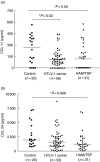Levels of serum chemokines discriminate clinical myelopathy associated with human T lymphotropic virus type 1 (HTLV-1)/tropical spastic paraparesis (HAM/TSP) disease from HTLV-1 carrier state
- PMID: 16879249
- PMCID: PMC1809672
- DOI: 10.1111/j.1365-2249.2006.03150.x
Levels of serum chemokines discriminate clinical myelopathy associated with human T lymphotropic virus type 1 (HTLV-1)/tropical spastic paraparesis (HAM/TSP) disease from HTLV-1 carrier state
Abstract
Approximately 5% of people infected with human T lymphotropic virus type 1 (HTLV-1) develop clinical myelopathy or tropical spastic paraparesis (HAM/TSP) that is associated with high-levels of Th1 cytokines, interferon (IFN)-gamma and tumour necrosis factor (TNF)-alpha. Chemokines are known to induce cytokine secretion and direct the trafficking of immune cells to sites of disease. The present study measured serum chemokines correlated with autonomously released IFN-gamma in cell cultures. HTLV-1 infection was defined by enzyme-linked immunosorbent assay (ELISA) and confirmed by Western blot. Subjects included HTLV-1 carriers (n = 56), patients with HAM/TSP (n = 31) and healthy HTLV-1 seronegative volunteer controls (n = 20). Serum chemokines and IFN-gamma autonomously released by mononuclear cells in culture were quantified by ELISA. Compared to HTLV-1 carriers, serum chemokines in HAM/TSP patients showed significantly increased levels of CXCL9 and CXCL10, significantly diminished levels of CCL2 and similar amounts of CCL11 and CCL24. In contrast, CCL11 and CCL24 were significantly lower in serum of HAM/TSP patients than either control. IFN-gamma was positively correlated with CXCL9 and CXCL10 when HAM/TSP and HTLV-1 carriers were used as a combined group. However, despite a large proportion of HTLV-1 carriers having high IFN-gamma levels, these chemokines were not increased in carriers. This study showed that high levels of CXCL9 and CXCL10 in the systemic circulation and low serum CCL2 levels are features of HAM/TSP. HTLV-1 infection and Tax and/or additional viral encoded factor-mediated pathological processes triggering T cell activation with autogenous IFN-gamma release are probably involved in regulating chemokine release.
Figures



Similar articles
-
Plasmatic proinflammatory chemokines levels are tricky markers to monitoring HTLV-1 carriers.J Med Virol. 2016 Aug;88(8):1438-47. doi: 10.1002/jmv.24481. Epub 2016 Feb 3. J Med Virol. 2016. PMID: 26800845
-
CSF-chemokines in HTLV-I-associated myelopathy: CXCL10 up-regulation and therapeutic effect of interferon-alpha.J Neuroimmunol. 2005 Feb;159(1-2):177-82. doi: 10.1016/j.jneuroim.2004.10.011. Epub 2004 Dec 15. J Neuroimmunol. 2005. PMID: 15652417
-
Modulation of T cell responses in HTLV-1 carriers and in patients with myelopathy associated with HTLV-1.Neuroimmunomodulation. 2006;13(3):145-51. doi: 10.1159/000097259. Epub 2006 Nov 21. Neuroimmunomodulation. 2006. PMID: 17119343
-
Therapeutic strategies in HTLV-I-associated myelopathy/tropical spastic paraparesis (HAM/TSP).Cent Nerv Syst Agents Med Chem. 2009 Jun;9(2):137-49. doi: 10.2174/187152409788452090. Cent Nerv Syst Agents Med Chem. 2009. PMID: 20021347 Review.
-
Cytokine Networks Dysregulation during HTLV-1 Infection and Associated Diseases.Viruses. 2018 Dec 5;10(12):691. doi: 10.3390/v10120691. Viruses. 2018. PMID: 30563084 Free PMC article. Review.
Cited by
-
The Role of Chemokines in the Pathogenesis of HTLV-1.Front Microbiol. 2020 Mar 13;11:421. doi: 10.3389/fmicb.2020.00421. eCollection 2020. Front Microbiol. 2020. PMID: 32231656 Free PMC article. Review.
-
Human T-lymphotropic virus type 1-infected cells secrete exosomes that contain Tax protein.J Biol Chem. 2014 Aug 8;289(32):22284-305. doi: 10.1074/jbc.M114.549659. Epub 2014 Jun 17. J Biol Chem. 2014. PMID: 24939845 Free PMC article.
-
Infective dermatitis has similar immunological features to human T lymphotropic virus-type 1-associated myelopathy/tropical spastic paraparesis.Clin Exp Immunol. 2009 Jun;156(3):455-62. doi: 10.1111/j.1365-2249.2008.03869.x. Clin Exp Immunol. 2009. PMID: 19438598 Free PMC article.
-
Evaluation of the microbicidal activity and cytokines/chemokines profile released by neutrophils from HTLV-1-infected individuals.Scand J Immunol. 2011 Sep;74(3):310-317. doi: 10.1111/j.1365-3083.2011.02579.x. Scand J Immunol. 2011. PMID: 21595736 Free PMC article.
-
Immunological and viral features in patients with overactive bladder associated with human T-cell lymphotropic virus type 1 infection.J Med Virol. 2012 Nov;84(11):1809-17. doi: 10.1002/jmv.23341. J Med Virol. 2012. PMID: 22997085 Free PMC article.
References
-
- Carvalho EM, Bacellar O, Porto AF, Braga S, Galvao-Castro B, Neva F. Cytokine profile and immunomodulation in asymptomatic human T-lymphotropic virus type 1-infected blood donors. J Acquir Immune Defic Syndr. 2001;27:1–6. - PubMed
-
- Edlich RF, Arnette JA, Williams FM. Global epidemic of human T-cell lymphotropic virus type-I (HTLV-I) J Emerg Med. 2000;18:109–19. - PubMed
-
- Uchiyama T. Human T cell leukemia virus type I (HTLV-I) and human diseases. Annu Rev Immunol. 1997;15:15–37. - PubMed
-
- Biddison WE, Kubota R, Kawanishi T, et al. Human T cell leukemia virus type I (HTLV-I)-specific CD8+ CTL clones from patients with HTLV-I-associated neurologic disease secrete proinflammatory cytokines, chemokines, and matrix metalloproteinase. J Immunol. 1997;159:2018–25. - PubMed
Publication types
MeSH terms
Substances
Grants and funding
LinkOut - more resources
Full Text Sources
Other Literature Sources
Research Materials
Miscellaneous

